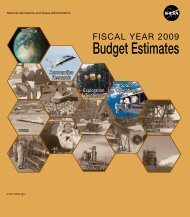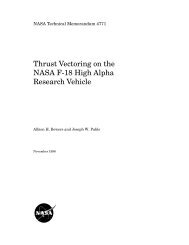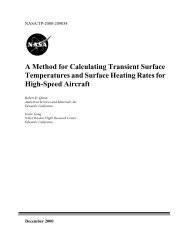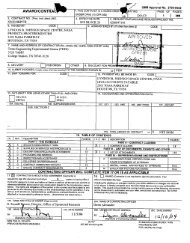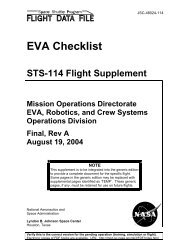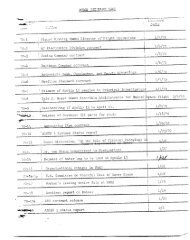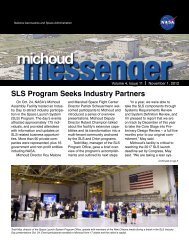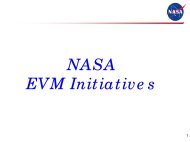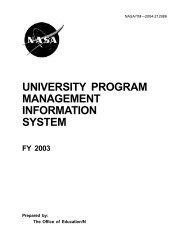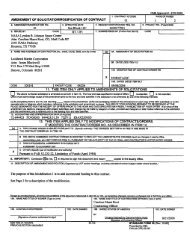Public BY10 KSC Shuttle Launch Control System (LCS) - NASA
Public BY10 KSC Shuttle Launch Control System (LCS) - NASA
Public BY10 KSC Shuttle Launch Control System (LCS) - NASA
- No tags were found...
Create successful ePaper yourself
Turn your PDF publications into a flip-book with our unique Google optimized e-Paper software.
Exhibit 300 (BY2010)PART ONEOVERVIEW1. Date of Submission: 2008-09-082. Agency: 0263. Bureau: 004. Name of this CapitalAsset:5. Unique ProjectIdentifier:<strong>KSC</strong> <strong>Shuttle</strong> <strong>Launch</strong> <strong>Control</strong> <strong>System</strong> (LCS)026-00-01-05-01-1409-006. What kind of investment will this be in FY2010?Operations and Maintenance7. What was the first budget year this investment was submitted to OMB?FY2001 or earlier8. Provide a brief summary and justification for this investment, including a brief description of how this closes in part or in whole an identified agencyperformance gap.The <strong>Launch</strong> <strong>Control</strong> <strong>System</strong> (LCS) investment maintains the unique hardware and software used at Kennedy Space Center toprocess and launch the Space <strong>Shuttle</strong>. The complex computer hardware and software provides control and monitor functionality aswell as the capability to record and simultaneously playback near real-time telemetry. The system currently operates with 100computer consoles using 12 million lines of custom source code. The LCS reliability is man-rated. The LCS consists of <strong>Shuttle</strong> DataCenter (SDC), Checkout <strong>Control</strong> and Monitor Subsystem (CCMS) Operations, Record and Playback Subsystem (RPS), and OtherSupporting <strong>System</strong>s (Other O&M). The <strong>Shuttle</strong> Data Center provides storage and recall of all shuttle processing and launch data.The CCMS is a custom designed computer hardware and software system for processing and launching the Space <strong>Shuttle</strong>. Thesystem currently operates with 100 consoles, 240 peripherals, 12 million lines of <strong>Launch</strong> Processing <strong>System</strong> (LPS) source code, and1.6 million lines of executable Ground Operations Aerospace Language (GOAL) code. The Record and Playback Subsystem (RPS)primary function is to record unprocessed <strong>Shuttle</strong> on-board instrumentation data during tests and launch countdowns. The Space<strong>Shuttle</strong> program and the functions supported by this IT investment have existed since the mid 1970s. During this period thebusiness management processes and the supporting financial management processes have changed to accommodate the evolvingprogram needs and reporting requirements. Rita Willcoxon's <strong>Shuttle</strong> IT investments comprise approximately 16% of her financialoversight responsibility at <strong>KSC</strong>. While <strong>NASA</strong> can report life-cycle costs for this program and its major projects, it is extremely difficultto trace back the entire life-cycle costs history associated with this IT investment. In Fiscal Year (FY) 2003 <strong>NASA</strong> moved to a fullcostbudgeting environment. For the purpose of this OMB Exhibit 300, the life cycle costs reported cover FY 2006 through theplanned termination of the program which the IT investment supports. The LCS is a steady state investment in the operationalphase of its life cycle. The loss of this investment would require us to revert to manual based systems. This would increase ourheadcount and impact our processing schedule. Current planning shows the Space <strong>Shuttle</strong> program ending in 2010.9. Did the Agency's Executive/Investment Committee approve this request?yes9.a. If "yes," what was the date of this approval?2008-06-1910. Did the Program/Project Manager review this Exhibit?yes11. Program/Project Manager Name:Rita WillcoxonProgram/Project Manager Phone:321.867.4343Program/Project Manager Email:rita.g.willcoxon@nasa.gov11.a. What is the current FAC-P/PM certification level of the project/program manager?Senior/Expert/DAWIA-Level 3
11.b. When was the Program/Project Manager Assigned?2006-12-0111.c. What date did the Program/Project Manager receive the FACP/PM certification? If the certification has not been issued, what is the anticipateddate for certification?2008-08-0812. Has the agency developed and/or promoted cost effective, energy-efficient and environmentally sustainable techniques or practices for this project.yes12.a. Will this investment include electronic assets (including computers)?yes12.b. Is this investment for new construction or major retrofit of a Federal building or facility? (answer applicable to non-IT assets only)no13. Does this investment directly support one of the PMA initiatives?yesIf yes, select the initiatives that apply:Competitive SourcingExpanded E-GovernmentFinancial Performance13.a. Briefly and specifically describe for each selected how this asset directly supports the identified initiative(s)? (e.g. If E-Gov is selected, is it anapproved shared service provider or the managing partner?)The LCS system has been developed and maintained over many years. Modifications and upgrades have been performed basedupon new technology and evolving knowledge of the requirements of launching a human-rated vehicle into space. Manymodifications are unique to Space Vehicle Processing and not readily available from general industry. When modifications arerequired the Agency adheres to Federal regulations of competitive sourcing, E-Government, and financial performance.14. Does this investment support a program assessed using the Program Assessment Rating Tool (PART)?yes14.a. If yes, does this investment address a weakness found during the PART review?no14.b. If yes, what is the name of the PARTed program?10000346 - Space <strong>Shuttle</strong>14.c. If yes, what rating did the PART receive?Adequate15. Is this investment for information technology?yes16. What is the level of the IT Project (per CIO Council's PM Guidance)?Level 317. What project management qualifications does the Project Manager have? (per CIO Council's PM Guidance)(1) Project manager has been validated as qualified for this investment18. Is this investment identified as high risk on the Q4 - FY 2008 agency high risk report (per OMB memorandum M-05-23)?no19. Is this a financial management system?no20. What is the percentage breakout for the total FY2010 funding request for the following? (This should total 100%)Hardware 18Software 19
Services 63Other 021. If this project produces information dissemination products for the public, are these products published to the Internet in conformance with OMBMemorandum 05-04 and included in your agency inventory, schedules and priorities?n/a22. Contact information of individual responsible for privacy related questions.NameMark MasonPhone Number321-867-3014Title<strong>KSC</strong> Information OfficerEmailmark.mason@nasa.gov23. Are the records produced by this investment appropriately scheduled with the National Archives and Records Administration's approval?yes24. Does this investment directly support one of the GAO High Risk Areas?noSUMMARY OF SPEND1. Provide the total estimated life-cycle cost for this investment by completing the following table. All amounts represent budget authority in millions,and are rounded to three decimal places. Federal personnel costs should be included only in the row designated Government FTE Cost, and should beexcluded from the amounts shown for Planning, Full Acquisition, and Operation/Maintenance. The total estimated annual cost of the investment is thesum of costs for Planning, Full Acquisition, and Operation/Maintenance. For Federal buildings and facilities, life-cycle costs should include long termenergy, environmental, decommissioning, and/or restoration costs. The costs associated with the entire life-cycle of the investment should be includedin this report.All amounts represent Budget Authority(Estimates for BY+1 and beyond are for planning purposes only and do not represent budget decisions)PY-1 & Earlier PY CY BY-2007 2008 2009 2010Planning Budgetary Resources 0 0 0 0Acquisition Budgetary Resources 0 0 0 0Maintenance Budgetary Resources 223.916 65.6004 45.1469 41.6279Government FTE Cost 0.111 0.0119 0.0125 0.0129# of FTEs0 0 0 0Note: For the cross-agency investments, this table should include all funding (both managing partner and partner agencies).Government FTE Costs should not be included as part of the TOTAL represented.2. Will this project require the agency to hire additional FTE's?no3. If the summary of spending has changed from the FY2009 President's budget request, briefly explain those changes.The budgetary increase in 2008 reflects new requirements for the first test flight of <strong>NASA</strong>'s new Ares 1-X booster. Ares I-X will belaunched from <strong>Launch</strong> Complex 39-B at <strong>NASA</strong>'s Kennedy Space Center in Florida.
PERFORMANCEIn order to successfully address this area of the exhibit 300, performance goals must be provided for the agency and be linked to the annualperformance plan. The investment must discuss the agency's mission and strategic goals, and performance measures (indicators) must be provided.These goals need to map to the gap in the agency's strategic goals and objectives this investment is designed to fill. They are the internal and externalperformance benefits this investment is expected to deliver to the agency (e.g., improve efficiency by 60 percent, increase citizen participation by 300percent a year to achieve an overall citizen participation rate of 75 percent by FY 2xxx, etc.). The goals must be clearly measurable investmentoutcomes, and if applicable, investment outputs. They do not include the completion date of the module, milestones, or investment, or general goals,such as, significant, better, improved that do not have a quantitative measure.Agencies must use the following table to report performance goals and measures for the major investment and use the Federal Enterprise Architecture(FEA) Performance Reference Model (PRM). Map all Measurement Indicators to the corresponding Measurement Area and Measurement Groupingidentified in the PRM. There should be at least one Measurement Indicator for each of the four different Measurement Areas (for each fiscal year). ThePRM is available at www.egov.gov. The table can be extended to include performance measures for years beyond the next President's Budget.FiscalYearStrategicGoalSupportedMeasurementAreaMeasurementGroupingMeasurementIndicatorBaselinePlannedImprovementto theBaselineActualResults1 2007Goal 1: Flythe <strong>Shuttle</strong>as safely aspossibleuntil itsretirement,not laterthan 2010.CustomerResultsCustomerSatisfactionEnd UserSatisfactionthrough themeasurement ofnumber of CRsimplemented touserâ€ssatisfaction.100%100%100%2 2007Goal 1: Flythe <strong>Shuttle</strong>as safely aspossibleuntil itsretirement,not laterthan 2010.CustomerResultsDelivery TimeAnnualpercentage On-Time Delivery ofLCS IT productssupport both thePrograms overallreliability andensureaffordability ofthe systemsOn-timeDelivery ofLCS ITProducts -Standards ofExcellence(SOE) = 95%Expectation =80%MaximumError Rate(MER) =>80%Maintain SOE of95% on-timedelivery ReestablishSOE of95% on-timedelivery eachyear from 2005to 2010100%3 2007Goal 1: Flythe <strong>Shuttle</strong>as safely aspossibleuntil itsretirement,not laterthan 2010.TechnologyServiceAvailabilityMonthlypercentage ofunplanned orunscheduledoutage supportsthe agencyâ€sgoal ofmaintaining highLCS systemreliability andhelps ensuresspace accessAvailability ofsystems:Standards ofExcellence(SOE) = 99%MaximumError Rate(MER) =>97%Maintain 99% orbetteravailability eachyear from 2005to 2010100%4 2007Goal 1: Flythe <strong>Shuttle</strong>as safely aspossibleuntil itsretirement,not laterthan 2010.Processes andActivitiesComplaintsMonthly averageof 4 or less DRsacross releasedLCS applicationssupports both thePrograms overallreliability andensuresaffordability ofthe systemsMonthlyaverage of 4or less DRsacrossreleased LCSapplicationsStandards ofExcellence(SOE) = 4 orlessDiscrepancyReportsMaintain SOE of4 or lessdiscrepancies(DRs) againstLCS releasedapplicationseach year from2005 to 20103
(DRs)Expectation =5 to 7 DRsMaximumError Rate(MER) = 8DRs5 2007 Goal 1: Flythe <strong>Shuttle</strong>as safely aspossibleuntil itsretirement,not laterthan 2010.Mission andBusinessResultsSpaceOperationsAchieve 100%on-orbit missionsuccess for all<strong>Shuttle</strong> missionslaunched in FY2010. Missionsuccess criteriaare thoseprovided to theprime contractorfor contractperformance feedetermination100% 100% 100%6 2008 Goal 1: Flythe <strong>Shuttle</strong>as safely aspossibleuntil itsretirement,not laterthan 2010.CustomerResultsCustomerSatisfactionEnd UserSatisfactionthrough themeasurement ofnumber of CRsimplemented touserâ€ssatisfaction.100% 100% 100%7 2008 Goal 1: Flythe <strong>Shuttle</strong>as safely aspossibleuntil itsretirement,not laterthan 2010.CustomerResultsDelivery TimeAnnualpercentage On-Time Delivery ofLCS IT productssupport both thePrograms overallreliability andensureaffordability ofthe systemsOn-timeDelivery ofLCS ITProducts -Standards ofExcellence(SOE) = 95%Expectation =80%MaximumError Rate(MER) =>80%Maintain SOE of95% on-timedelivery ReestablishSOE of95% on-timedelivery eachyear from 2005to 2010100%8 2008 Goal 1: Flythe <strong>Shuttle</strong>as safely aspossibleuntil itsretirement,not laterthan 2010.TechnologyServiceAvailabilityMonthlypercentage ofunplanned orunscheduledoutage supportsthe agencyâ€sgoal ofmaintaining highLCS systemreliability andhelps ensuresspace accessAvailability ofsystems:Standards ofExcellence(SOE) = 99%MaximumError Rate(MER) =>97%Maintain 99% orbetteravailability eachyear from 2005to 2010100%9 2008 Goal 1: Flythe <strong>Shuttle</strong>as safely aspossibleuntil itsretirement,not laterthan 2010.Processes andActivitiesComplaintsMonthly averageof 4 or less DRsacross LCSapplicationssupportsProgram'sreliability andensuresaffordability ofthe systems. GoalMonthlyaverage of 4or less DRsacrossreleased LCSapplicationsStandards ofExcellence(SOE) = 4 orlessMaintain SOE of4 or lessdiscrepancies(DRs) againstLPS releasedapplicationseach year from2005 to 20103
8: Ensure the Discrepancyprovision of Reportsspace access, and (DRs)improve it by Expectation =increasing safety, 5 to 7 DRsreliability, and Maximumaffordability Error Rate(MER) = 8DRs10 2008 Goal 1: Flythe <strong>Shuttle</strong>as safely aspossibleuntil itsretirement,not laterthan 2010.Mission andBusinessResultsSpaceOperationsAchieve 100%on-orbit missionsuccess for all<strong>Shuttle</strong> missionslaunched in FY2010. Missionsuccess criteriaare thoseprovided to theprime contractorfor contractperformance feedetermination100% 100% 100%11 2009 Goal 1: Flythe <strong>Shuttle</strong>as safely aspossibleuntil itsretirement,not laterthan 2010.CustomerResultsCustomerSatisfactionEnd UserSatisfactionthrough themeasurement ofnumber of CRsimplemented touserâ€ssatisfaction.100% 100% TBD12 2009 Goal 1: Flythe <strong>Shuttle</strong>as safely aspossibleuntil itsretirement,not laterthan 2010.CustomerResultsDelivery TimeAnnualpercentage On-Time Delivery ofLCS IT productssupport both thePrograms overallreliability andensureaffordability ofthe systemsOn-timeDelivery ofLCS ITProducts -Standards ofExcellence(SOE) = 95%Expectation =80%MaximumError Rate(MER) =>80%Maintain SOE of95% on-timedelivery ReestablishSOE of95% on-timedelivery eachyear from 2005to 2010TBD13 2009 Goal 1: Flythe <strong>Shuttle</strong>as safely aspossibleuntil itsretirement,not laterthan 2010.TechnologyServiceAvailabilityMonthlypercentage ofunplanned orunscheduledoutage supportsthe agencyâ€sgoal ofmaintaining highLCS systemreliability andhelps ensuresspace accessAvailability ofsystems:Standards ofExcellence(SOE) = 99%MaximumError Rate(MER) =>97%Maintain 99% orbetteravailability eachyear from 2005to 2010TBD14 2009 Goal 1: Flythe <strong>Shuttle</strong>as safely aspossibleuntil itsretirement,not laterthan 2010.Processes andActivitiesComplaintsMonthly averageof 4 or less DRsacross releasedLCS applicationssupports both thePrograms overallreliability andensuresMonthlyaverage of 4or less DRsacrossreleased LCSapplicationsStandards ofExcellenceMaintain SOE of4 or lessdiscrepancies(DRs) againstLCS releasedapplicationseach year from2005 to 2010TBD
affordability ofthe systems(SOE) = 4 orlessDiscrepancyReports(DRs)Expectation =5 to 7 DRsMaximumError Rate(MER) = 8DRs15 2009 Goal 1: Flythe <strong>Shuttle</strong>as safely aspossibleuntil itsretirement,not laterthan 2010.Mission andBusinessResultsSpaceOperationsAchieve 100%on-orbit missionsuccess for all<strong>Shuttle</strong> missionslaunched in FY2010. Missionsuccess criteriaare thoseprovided to theprime contractorfor contractperformance feedetermination100% 100% TBD16 2010 Goal 1: Flythe <strong>Shuttle</strong>as safely aspossibleuntil itsretirement,not laterthan 2010.CustomerResultsCustomerSatisfactionEnd UserSatisfactionthrough themeasurement ofnumber of CRsimplemented touserâ€ssatisfaction.100% 100% TBD17 2010 Goal 1: Flythe <strong>Shuttle</strong>as safely aspossibleuntil itsretirement,not laterthan 2010.CustomerResultsDelivery TimeAnnualpercentage On-Time Delivery ofLCS IT productssupport both thePrograms overallreliability andensureaffordability ofthe systemsOn-timeDelivery ofLCS ITProducts -Standards ofExcellence(SOE) = 95%Expectation =80%MaximumError Rate(MER) =>80%Maintain SOE of95% on-timedelivery ReestablishSOE of95% on-timedelivery eachyear from 2005to 2010TBD18 2010 Goal 1: Flythe <strong>Shuttle</strong>as safely aspossibleuntil itsretirement,not laterthan 2010.TechnologyServiceAvailabilityMonthlypercentage ofunplanned orunscheduledoutage supportsthe agencyâ€sgoal ofmaintaining highLCS systemreliability andhelps ensuresspace accessAvailability ofsystems:Standards ofExcellence(SOE) = 99%MaximumError Rate(MER) =>97%Maintain 99% orbetteravailability eachyear from 2005to 2010TBD19 2010 Goal 1: Flythe <strong>Shuttle</strong>as safely aspossibleuntil itsretirement,Processes andActivitiesComplaintsMonthly averageof 4 or less DRsacross releasedLCS applicationssupports both thePrograms overallMonthlyaverage of 4or less DRsacrossreleased LCSapplicationsMaintain SOE of4 or lessdiscrepancies(DRs) againstLCS releasedapplicationsTBD
not laterthan 2010.reliability andensuresaffordability ofthe systemsStandards of each year fromExcellence 2005 to 2010(SOE) = 4 orlessDiscrepancyReports(DRs)Expectation =5 to 7 DRsMaximumError Rate(MER) = 8DRs20 2010 Goal 1: Flythe <strong>Shuttle</strong>as safely aspossibleuntil itsretirement,not laterthan 2010.Mission andBusinessResultsSpaceOperationsAchieve 100%on-orbit missionsuccess for all<strong>Shuttle</strong> missionslaunched in FY2010. Missionsuccess criteriaare thoseprovided to theprime contractorfor contractperformance feedetermination100% 100% TBDEAIn order to successfully address this area of the business case and capital asset plan you must ensure the investment is included in the agency's EAand Capital Planning and Investment <strong>Control</strong> (CPIC) process, and is mapped to and supports the FEA. You must also ensure the business casedemonstrates the relationship between the investment and the business, performance, data, services, application, and technology layers of theagency's EA.1. Is this investment included in your agency's target enterprise architecture?yes2. Is this investment included in the agency's EA Transition Strategy?yes2.a. If yes, provide the investment name as identified in the Transition Strategy provided in the agency's most recent annual EA Assessment.<strong>KSC</strong> <strong>Shuttle</strong> <strong>Launch</strong> <strong>Control</strong> <strong>System</strong>3. Is this investment identified in a completed (contains a target architecture) and approved segment architecture?yes3.a. If yes, provide the six digit code corresponding to the agency segment architecture. The segment architecture codes are maintained by the agencyChief Architect.463-0004. Identify the service components funded by this major IT investment (e.g., knowledge management, content management, customer relationshipmanagement, etc.). Provide this information in the format of the following table. For detailed guidance regarding components, please refer tohttp://www.whitehouse.gov/omb/egov/.Component: Use existing SRM Components or identify as NEW. A NEW component is one not already identified as a service component in the FEASRM.Reused Name and UPI: A reused component is one being funded by another investment, but being used by this investment. Rather than answer yesor no, identify the reused service component funded by the other investment and identify the other investment using the Unique Project Identifier (UPI)code from the OMB Ex 300 or Ex 53 submission.Internal or External Reuse?: Internal reuse is within an agency. For example, one agency within a department is reusing a service component providedby another agency within the same department. External reuse is one agency within a department reusing a service component provided by anotheragency in another department. A good example of this is an E-Gov initiative service being reused by multiple organizations across the federalgovernment.Funding Percentage: Please provide the percentage of the BY requested funding amount used for each service component listed in the table. Ifexternal, provide the funding level transferred to another agency to pay for the service.
service.12 Space andGroundNetwork ITSupportUsers can access a24x7 help desk consoleby phone or submitelectronic requests forservice.CustomerInitiatedAssistanceReservations /RegistrationNo Reuse 113 Space andGroundNetwork ITSupportProcesses are trackedusing DocumentumTracking andWorkflowProcess Tracking No Reuse 214 Space andGroundNetwork ITSupportIssues are documentedusing Problem Reportsor PRACATracking andWorkflowCaseManagementNo Reuse 315 Space andGroundNetwork ITSupportIssues are escalated upthrough the USA and<strong>NASA</strong> managementchain until resolution isreachedTracking andWorkflowConflictResolutionNo Reuse 116 Space andGroundNetwork ITSupportMicrosoft Outlook is thestandard USA tool formanaging electroniccommunicationsRouting andSchedulingInboundCorrespondenceManagementNo Reuse 117 Space andGroundNetwork ITSupportMicrosoft Outlook is thestandard USA tool formanaging electroniccommunicationsRouting andSchedulingOutboundCorrespondenceManagementNo Reuse 118 Space andGroundNetwork ITSupportChanges are managedthrough a Change<strong>Control</strong> Board (CCB)and controlledelectronically throughSCMS, Maximo, andDocumentumManagementof ProcessesChangeManagementNo Reuse 319 Space andGroundNetwork ITSupportCM is maintainedthrough Documentum,Maximo, and PeoplesoftManagementof ProcessesConfigurationManagementNo Reuse 320 Space andGroundNetwork ITSupportSoftware requirementsare managed throughDOORS and RPRSManagementof ProcessesRequirementsManagementNo Reuse 321 Space andGroundNetwork ITSupportLCS utilizes MicrosoftProject, Maximo, andPeoplesoft for projectmanagementManagementof ProcessesProgram /ProjectManagementNo Reuse 122 Space andGroundNetwork ITSupportPolicies are maintainedand managed throughDocumentumManagementof ProcessesGovernance /PolicyManagementNo Reuse 323 Space andGroundNetwork ITSupportQuality processes arecontrolled throughDocumentum andMaximoManagementof ProcessesQualityManagementNo Reuse 224 Space andGroundN etwork ITSupportBusiness rules areenforced throughD ocumentum, M aximoand PeoplesoftManagementof ProcessesBusiness RuleManagementNo Reuse 1
Network ITSupportDocumentum, Maximoand Peoplesoft25 Space andGroundNetwork ITSupportLCS uses the standardUSA Risk ManagementprocessManagementof ProcessesRiskManagementNo Reuse 226 Space andGroundNetwork ITSupportLCS utilizes thestandard USA suite ofOffice toolsOrganizationalManagementWorkgroup /GroupwareNo Reuse 227 Space andGroundNetwork ITSupportNetwork managementis performed using HPOpen ViewOrganizationalManagementNetworkManagementNo Reuse 228 Space andGroundNetwork ITSupportMicrosoft Project, Excel,and Word are used forstrategic planningeffortsInvestmentManagementStrategicPlanning andMgmtNo Reuse 129 Space andGroundNetwork ITSupportLCS performance ismanaged in the COFusing the HP Open Viewtool suiteInvestmentManagementPerformanceManagementNo Reuse 230 Space andGroundNetwork ITSupportMaximo is used forwork authoringcapabilities.ContentManagementContentAuthoringNo Reuse 231 Space andGroundNetwork ITSupportElectronic signaturesare used in Maximo toapprove workContentManagementContent Reviewand ApprovalNo Reuse 132 Space andGroundNetwork ITSupportLCS Documentationuses documentationscanners and softwareDocumentManagementDocumentImaging andOCRNo Reuse 233 Space andGroundNetwork ITSupportDocuments are postedin Documentum andavailable on theintranetDocumentManagementDocumentReferencingNo Reuse 334 Space andGroundNetwork ITSupportFrame maker andMicrosoft Wordsoftware are used forRevision control of LCSDocumentationDocumentManagementDocumentRevisionsNo Reuse 335 Space andGroundNetwork ITSupportDocuments aremanaged inDocumentumDocumentManagementLibrary / Storage No Reuse 336 Space andGroundNetwork ITSupportDocuments arereviewed and approvedin DocumentumDocumentManagementDocumentReview andApprovalNo Reuse 337 Space andGroundNetwork ITSupportLCS Documentationhandles conversionsbetween differentsoftware file typeswhen neededDocumentManagementDocumentConversionNo Reuse 3
38 Space andGroundNetwork ITSupportLCS supports Indexingby maintaining theinfrastructure includingservers, documentmanagement software,storage and networkservicesDocumentManagementIndexing No Reuse 239 Space andGroundNetwork ITSupportLCS supportsClassification bymaintaining theinfrastructure includingservers, documentmanagement software,storage and networkservicesDocumentManagementIndexing No Reuse 240 Space andGroundNetwork ITSupportLCS supportsInformation Retrievalby maintaining theinfrastructure includingservers, databases,storage and networkservicesKnowledgeManagementInformationRetrievalNo Reuse 341 Space andGroundNetwork ITSupportInformation is sharedvia the intranetKnowledgeManagementInformationSharingNo Reuse 242 Space andGroundNetwork ITSupportRelated information canbe linked viaDocumentum or on theintranetRecordsManagementRecord Linking /AssociationNo Reuse 243 Space andGroundNetwork ITSupportDocumentum providesclassification types forLCS documentsRecordsManagementDocumentClassificationNo Reuse 244 Space andGroundNetwork ITSupportLCS information isarchived to tape or CDwhen immediate accessis no longer requiredRecordsManagementDocumentRetirementNo Reuse 245 Space andGroundNetwork ITSupportLCS creates mathmodels for use insimulationsKnowledgeDiscoveryModeling No Reuse 346 Space andGroundNetwork ITSupportLCS creates mathmodels for use insimulationsAnalysis andStatisticsMathematical No Reuse 147 Space andGroundNetwork ITSupportMicrosoft Excel is thestandard USA tool forcreating graphs.Microsoft Powerpoint isthe standard USA toolfor creating briefingchartsVisualization Graphing /ChartingNo Reuse 148 Space andGroundNetwork ITSupportLCS imagery is storedand viewed on theintranetVisualization Imagery No Reuse 1
49 Space andGroundNetwork ITSupportCAD work is performedusing AutoCadVisualization CAD No Reuse 350 Space andGroundNetwork ITSupportThe standard USA setof office tools is used tosupport planning effortsBusinessIntelligenceDecision Supportand PlanningNo Reuse 151 Space andGroundNetwork ITSupportThe standard USA setof office tools is used tosupport demandforecastBusinessIntelligenceDemandForecasting /MgmtNo Reuse 152 Space andGroundNetwork ITSupportData in LCS isexchanged via SDC, e-mail or the intranetDataManagementData Exchange No Reuse 153 Space andGroundNetwork ITSupportLCS data is stored andarchived via SDC or theUSA Ground OpsnetworksDataManagementData Warehouse No Reuse 154 Space andGroundNetwork ITSupportLoading and Archivingof data is accomplishedvia contacting the LPSsupport console in theCOFDataManagementLoading andArchivingNo Reuse 155 Space andGroundNetwork ITSupportLoading and Archivingof data is accomplishedvia contacting the LPSsupport console in theCOFDataManagementData Recovery No Reuse 156 Space andGroundNetwork ITSupportLCS employees are paidvia the normal USApayroll systemFinancialManagementPayroll No Reuse 157 Space andGroundNetwork ITSupportLCS Financial data isaudited in the USAbusiness ManagementofficeFinancialManagementAuditing No Reuse 158 Space andGroundNetwork ITSupportLCS Financial data isaudited in the USAbusiness ManagementofficeFinancialManagementBilling andAccountingNo Reuse 15. To demonstrate how this major IT investment aligns with the FEA Technical Reference Model (TRM), please list the Service Areas, Categories,Standards, and Service Specifications supporting this IT investment.FEA SRM Component: Service Components identified in the previous question should be entered in this column. Please enter multiple rows for FEASRM Components supported by multiple TRM Service Specifications.Service Specification: In the Service Specification field, Agencies should provide information on the specified technical standard or vendor productmapped to the FEA TRM Service Standard, including model or version numbers, as appropriate.SRM Component Service Area Service Category Service Standard Service Specification (i.e.,vendor and product name)1 InboundCorrespondenceManagementService Access andDeliveryAccess Channels Web Browser Microsoft Internet Explorer
2InboundCorrespondenceManagementService Access andDeliveryAccess Channels Wireless / PDA Palm OS3 OutboundCorrespondenceManagement4 OutboundCorrespondenceManagement5 OutboundCorrespondenceManagement6 OutboundCorrespondenceManagementService Access andDeliveryService Access andDeliveryService Access andDeliveryService Access andDeliveryDelivery Channels Internet NISNDelivery Channels Intranet NISN, USADelivery Channels Extranet NISNDelivery Channels Peer to Peer (P2P) NISN, USA7 OutboundCorrespondenceManagementService Access andDeliveryDelivery ChannelsVirtual PrivateNetwork (VPN)Cisco8 ConfigurationManagementService Access andDeliveryServiceRequirementsLegislative /Compliance<strong>NASA</strong> Headquarters9 ConfigurationManagementService Access andDeliveryServiceRequirementsAuthentication /Single Sign-onRSA Keon10 ConfigurationManagementService Access andDeliveryServiceRequirementsHostingHP Proliant, Dell; Tru64, DEC;Linux, Redhat11 ConfigurationManagementService Access andDeliveryService TransportSupporting NetworkServicesCisco <strong>System</strong>s12 Software Development Service Platform andInfrastructureSoftwareEngineeringTest ManagementN/A13 Software Development Service Platform andInfrastructureSoftwareEngineeringModelingArena14 Library / Storage Service Platform andInfrastructure15 Library / Storage Service Platform andInfrastructureDatabase / Storage Database OracleDatabase / Storage Storage Storage Tech, EMC16 Software Development Service Platform andInfrastructureHardware /InfrastructureServers / ComputersHP Proliant, Dell17 Software Development Service Platform andInfrastructureHardware /InfrastructureEmbeddedTechnology DevicesN/A18 Software Development Service Platform andInfrastructureHardware /InfrastructurePeripheralsHP Printers, Lanier Printers19 Software Development Service Platform andInfrastructureHardware /InfrastructureWide Area Network(WAN)NISN20 Software Development Service Platform andInfrastructureHardware /InfrastructureLocal Area Network(LAN)KICS21 Software Development Service Platform andInfrastructureHardware /InfrastructureNetwork Devices /StandardsCisco <strong>System</strong>s22 Software Development Service Platform andInfrastructureHardware /InfrastructureVideo ConferencingMicrosoft Netmeeting23 Risk Management ComponentFrameworkSecurityCertificates / DigitalSignaturesRSA Keon
24 Risk Management ComponentFrameworkSecuritySupporting SecurityServicesISS25 Graphing / Charting ComponentFrameworkUser Presentation /InterfaceStatic DisplayMicrosoft Visio, Powerpoint26 Graphing / Charting ComponentFrameworkUser Presentation /InterfaceDynamic Server-SideDisplayMicrosoft IIS Active ServerPages, Adobe Coldfusion27 Graphing / Charting ComponentFrameworkUser Presentation /InterfaceContent RenderingAutorender Pro28 Graphing / Charting ComponentFrameworkUser Presentation /InterfaceWireless / Mobile /VoiceAT&T, Sprint Nextel/Nokia,Samsung, Research in Motion29 ConfigurationManagementService Interface andIntegrationInteroperability Data Format /ClassificationTrack Studio30 ConfigurationManagementService Interface andIntegrationIntegration Middleware Oracle31 ConfigurationManagementService Interface andIntegrationIntegrationEnterprise ApplicationIntegrationDocumentum32 Record Linking /AssociationService Interface andIntegrationInteroperability Data Format /ClassificationN/A33 Record Linking /AssociationService Interface andIntegrationInteroperability Data Types /ValidationN/A34 Record Linking /Association35 ConfigurationManagementService Interface andIntegrationService Interface andIntegrationInteroperability Data Transformation N/AInterface Service Discovery N/A36 ConfigurationManagementService Interface andIntegrationInterface Service Description /InterfaceN/A6. Will the application leverage existing components and/or applications across the Government (i.e., FirstGov, Pay.Gov, etc)?noPART THREERISKYou should perform a risk assessment during the early planning and initial concept phase of the investmentâ€s life-cycle, develop a risk-adjustedlife-cycle cost estimate and a plan to eliminate, mitigate or manage risk, and be actively managing risk throughout the investmentâ€s life-cycle.Answer the following questions to describe how you are managing investment risks.1. Does the investment have a Risk Management Plan?yes1.a. If yes, what is the date of the plan?2007-02-191.b. Has the Risk Management Plan been significantly changed since last year's submission to OMB?no1. Was operational analysis conducted?yes1.a. If yes, provide the date the analysis was completed.2008-05-09What were the results of your operational analysis?COST & SCHEDULE
<strong>Launch</strong> and Landing tracks performance at a level higher than IT specific investments, which are imbedded in the various budgetelements. Updates and changes to the <strong>Launch</strong> <strong>Control</strong> <strong>System</strong> must follow well-documented consistent processes to ensurecompatibility with all flight system interfaces. Focus is on demonstrating desired performance while increasing reliability, usability,and maintainability, resulting in improvements to flight safety. Software changes follow industry recognized CMMI Level IIIapproved reliable development processes. Requirements are generated by <strong>Shuttle</strong> Engineering specialists and reviewed withdevelopment engineers to ensure clear direction before beginning design. COTS and MOTS purchased products undergo receivinginspection in addition to verification testing. Hardware changes require a Certification Requirements plan describing the NSTSrequirement paragraphs which may be affected, and a Certification Approval Request plan demonstrating compliance with allassociated requirements. Prior to funding, all software and hardware changes to the LCS must be reviewed and approved by theIDS Configuration <strong>Control</strong> Board, a Level II Delegate Board. Large scale software/hardware changes which have the potential toimpact multiple systems are reviewed on a case by case basis by the Engineering Review Board, the Risk Review Board and possiblyrequire a formal Design Certification Review prior to implementation. The systems of the <strong>Launch</strong> <strong>Control</strong> <strong>System</strong> participate in theannual Planning, Programming, Budgeting, and Execution (PPBE) process to determine which assets require investment to bringtheir performance, or sustain their performance, within expected and acceptable operating parameters. This survey seeks technicaldata on system performance and cost, including cost payback based on investment versus sustained operations and maintenancecost, as well as a system risk assessment that characterizes system risk should the investment not be made versus system risk postinvestment. Cost, schedule, and risk are used to characterize and prioritize investment candidates during the process. Considerableweight is given to investments that mitigate significant safety risks. Cost-payback analysis is also considered a significant factor inanalyzing which investments the <strong>Shuttle</strong> Program will make.



